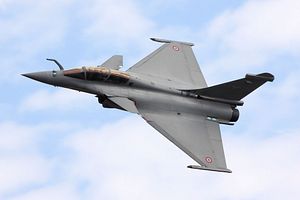Last month, India and France concluded a long-awaited deal that would see the transfer of 36 Dassault Rafale multi-role fighters to India in fly-away condition. Despite lingering questions around pricing, the Rafale deal will help the Indian Air Force fill an important capability starting in 2019, when the first Rafale jet is expected to arrive in India.
However, 36 jets still leaves the IAF far short of its sanctioned squadron strength. The Indian Air Force ideally wants to field between 42 and 45 squadrons by the late-2020s and getting there will require additional procurement — especially as much of its existing inventory continues to march toward obsolescence and some of its newer jets, like the Su-30MKI, have faced technical difficulties in recent years as well.
Of course, before we had the 36-jet government-to-government take on the Rafale acquisition, India had the Medium Multi-Role Combat Aircraft (MMRCA) tender — once known as the “mother of all defense deals.” Through the MMRCA, India sought to acquire 126 jets, seeking to manufacture 112 within India. Ultimately, liability and quality assurance issues bogged down negotiations with Dassault, leading to the collapse of the MMRCA altogether.
Though the MMRCA is dead, its ghost continues to linger. Reports have persisted throughout 2016 that the Indian Air Force is pushing for a large fighter acquisition, with a significant domestic manufacturing component, in line with Indian Prime Minister Narendra Modi’s “Make in India” initiative.
Sanjeev Miglani reports at Reuters that Delhi may pursue a 200-to-300-jet deal for single-engine planes in India. If concluded with a single manufacturer, the deal may be India’s largest ever, even dwarfing the original MMRCA.
In line with previous reports, the United States’ Lockheed Martin and Sweden’s Saab are interested in offering their F-16 and Gripen fighters respectively. Lockheed may be looking into setting up an assembly line in India to offer jets for export to third countries as well. Boeing, another U.S. firm, may look to offer its F/A-18 Hornets as well, as I discussed earlier this year.
The Indian Air Force may look to fully retire its Soviet-era fighter inventory, helping partly alleviate the maintenance, logistics, and supply costs associated with maintaining a fighter fleet comprised of platforms from several external providers, including Russia, France, and now potentially the United States or Sweden.
In addition to helping the IAF get closer to its sanctioned squadron strength, any potential deal that may be in the offing will hinge on technology transfer — something that India missed out on with the evaporation of the MMRCA and the terms of the final Rafale deal. As the MMRCA saga and the two-year negotiation process for the government-to-government Rafale deal demonstrate, getting from planned procurement to a concluded deal may be difficult.

































